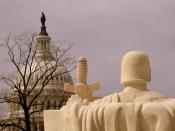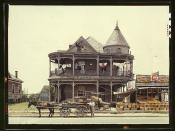The Constitution is often hailed as a marvel of brevity and of clarity. It was, however, written in the 18th century, and many of the ideas, concepts, words, phrases, and euphemisms seem odd to us today, if not down right foreign. Some of the more obscure words are defined in The Glossary.
But what of the Constitution itself? What does it mean? What does each article, each section, say?
This page is like a synopsis or summary of the Constitution, article by article, amendment by amendment. This should not be taken as a substitute for the Constitution, but more like a study guide.
The Preamble to the Constitution has no force in law; instead, it establishes the "Why" of the Constitution. Why is this document in existence? It reflects the desires of the Framers to improve on the government they currently had (to be "more perfect" than the Articles of Confederation), to ensure that that government would be just, and would protect its citizens from internal strife and from attack from the outside.
It would be of benefit to the people, rather than to its detriment. And, perhaps as importantly, it intended to do the same for the future generations of Americans.
The Articles
Article 1 establishes the first of the three branches of the government, the Legislature.
*Section 1 establishes the name of the Legislature to be The Congress, a bicameral, or two-part, body.
*Section 2 defines the House of Representatives, known as the lower house of Congress. It establishes a few minimum requirements, like a 25-year-old age limit, and establishes that the people themselves will elect the members for two years each. The members of the House are divided among the states proportionally, or according to size, giving more populous states more representatives in the House. The leader...


